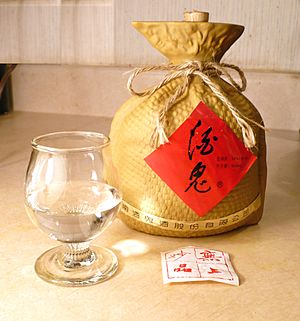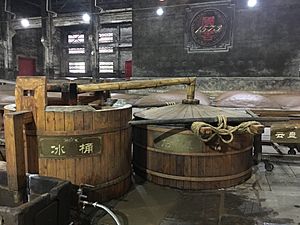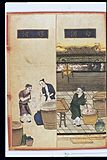Baijiu facts for kids

A glass and bottle of “Jiugui” (酒鬼) brand baijiu
|
|
| Type | Distilled beverage |
|---|---|
| Country of origin | China |
| Region of origin | East Asia |
| Alcohol by volume | 35–65% |
| Proof (US) | 56–130 |
| Color | Clear |
| Variants | light aroma, strong aroma, sauce aroma, rice aroma, phoenix aroma, mixed aroma, chi aroma, sesame aroma, medicine aroma, extra-strong aroma, special aroma, laobaigan, small qu baijiu |
| Related products | shōchū, soju, huangjiu, mijiu, sake |
| Baijiu | |||||||||||||||||||||||
|---|---|---|---|---|---|---|---|---|---|---|---|---|---|---|---|---|---|---|---|---|---|---|---|

"Baijiu" in Chinese characters
|
|||||||||||||||||||||||
| Chinese | 白酒 | ||||||||||||||||||||||
| Literal meaning | "white (clear) liquor" | ||||||||||||||||||||||
|
|||||||||||||||||||||||
| Alternative Chinese name | |||||||||||||||||||||||
| Simplified Chinese | 烧酒 | ||||||||||||||||||||||
| Traditional Chinese | 燒酒 | ||||||||||||||||||||||
| Literal meaning | burnt (distilled) liquor | ||||||||||||||||||||||
|
|||||||||||||||||||||||
Baijiu (Chinese: 白酒; pinyin: báijiǔ; literally "white (clear) liquor") is a clear Chinese drink. It is also known as shaojiu. This drink usually has a strong alcohol content. It can be from 35% to 60% alcohol by volume (ABV). ABV tells you how much pure alcohol is in the drink.
Baijiu is made from fermented grains. The most common grain used is sorghum. Sometimes, other grains like rice, wheat, barley, millet, or Job's tears are used.
A special ingredient called qū is very important. Qū is a starter culture, like yeast. It helps the grains ferment and gives each baijiu its unique taste. It is usually made from crushed wheat or steamed rice.
Baijiu looks similar to other clear drinks from East Asia. For example, Japanese shōchū or Korean soju. However, baijiu often has much more alcohol in it.
Contents
History of Baijiu
The exact start date for modern baijiu is not known. It likely developed slowly over many years. This happened as people learned more about making distilled drinks.
- People in China made alcohol as early as the Stone Age. Scientists have found old containers for drinks from that time.
- A proper way to distill drinks probably started during the Han Dynasty (202 BC-220 AD). Old art shows scenes of distilling.
- The first type of baijiu might have appeared during the Tang Dynasty (618-907). Poets from that time wrote about the drink.
- During the Song Dynasty (960-1279), trade and cities grew. This made alcohol more popular. Many pubs opened in big cities.
- At this time, baijiu was probably weaker, about 15% alcohol. People drank "bowls of alcohol," which suggests it was not as strong as today's baijiu.
- During the Yuan Dynasty (1271-1368), new distilling ideas came to China from the Middle East. This helped make stronger alcohol possible.
- By the Ming Dynasty (1368-1644), distilling had improved a lot. Baijiu started to look like the drink we know today. A book called Bencao Gangmu described baijiu in detail.
- Baijiu continued to get better over the centuries. Makers kept improving their techniques.
Baijiu is made by fermenting grains in a solid state. This means the grains are not in a liquid. The qū culture helps turn starches into sugars and then into alcohol at the same time. This method is common for drinks made in East Asia. Chinese baijiu is always made from grains, in batches, and then mixed together.
How to Drink Baijiu
Traditional Ways to Serve Baijiu
Traditionally, people in China drink baijiu neat. This means it is served without ice or mixers. It is usually served at room temperature in small cups. The type of cup can be different depending on the region. It's common to drink baijiu with food. Sometimes, it is flavored with fruit or herbs.
There are some special steps for drinking baijiu in a traditional way:
- First, you might do a Baili (拜礼) greeting. This shows respect to the host.
- Sometimes, a small amount of baijiu is poured on the ground. This shows thanks to nature.
- Take a small sip to taste the baijiu. Then, you can tell the host what you think.
- After a "Ganbei" (干杯, 'Cheers') and clinking glasses, you finish the small glass in one go.
The host usually starts by inviting guests to drink. Guests then respond by offering a cup back.
Modern Ways to Enjoy Baijiu
Today, some of the old ceremonial parts are not always followed. When friends or family drink together, the host might just say "Cheers for...!" (为...干杯!). Then, everyone clinks glasses and finishes their drinks. Tasting the baijiu is still a good idea.
Baijiu in Chinese Business Culture
Chinese business meetings can be very serious. It is a tradition to serve strong baijiu during business dinners. Some people, especially in the countryside, believe that drinking a lot shows strength. They also believe you should not refuse a drink offered by an older person or someone important.
Images for kids
See also
 In Spanish: Baijiu para niños
In Spanish: Baijiu para niños









